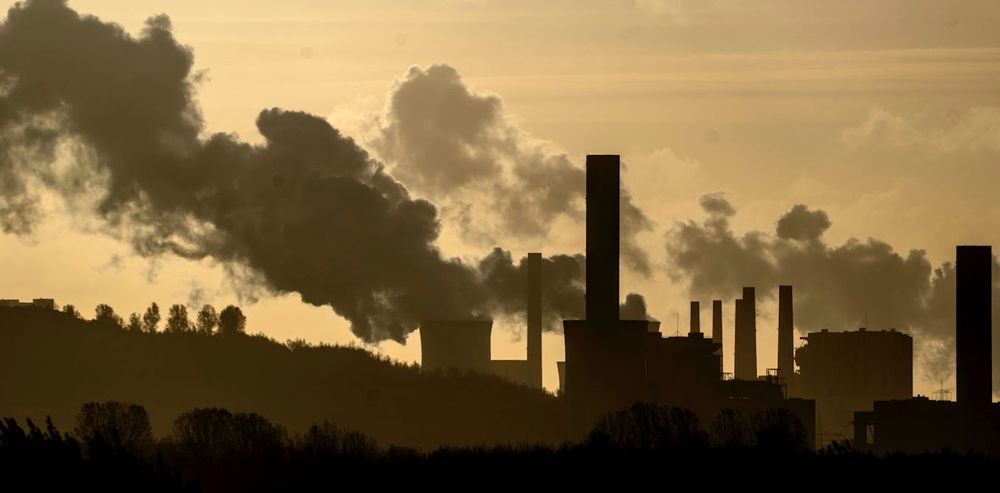
BREAKING: Donner Resigns as Co-Chair of Canada’s Net-Zero Advisory Body
University of British Columbia climate scientist Simon Donner has resigned as co-chair of Canada’s Net-Zero Advisory Body (NZAB).
This resignation is worth noting. @simondonner.bsky.social is a man of impeccable integrity. If he is saying the process, and the politics, is compromised and broken, that does not bode well for climate action in Carney's Canada.
www.theenergymix.com/breaking-don...
04.12.2025 15:03 — 👍 118 🔁 55 💬 5 📌 7
The MOU with Alberta is deeply disappointing. It sacrifices climate policies, places too many eggs in the industrial pricing basket, proposes a pipeline deal that would increase emissions, and would have Canada double-down on fossil fuels at a time the world is moving towards clean energy.
28.11.2025 20:10 — 👍 27 🔁 11 💬 2 📌 0

The Guardian
Opinion
Another Cop wrecked by fossil fuel interests and our leaders' cowardice - but there is another way
Genevieve Guenther
The fingerprints of Russia and Saudi Arabia are all over the decision text in Brazil. But a group of nations led by Colombia and the Netherlands offer hope
My latest: #COP30, global climate politics, and what happens next — for @theguardian.com
www.theguardian.com/commentisfre...
24.11.2025 12:25 — 👍 211 🔁 81 💬 6 📌 9
“Hard to abate” is the climate wonk’s term for an industry with no immediate route to zero carbon emissions. But I think there’s “hard to abate” & “expensive to abate” & then there’s “it’s just a bit difficult & we can’t really be bothered to abate”. None of this is impossible. We need to *choose*.
20.09.2025 07:17 — 👍 212 🔁 59 💬 12 📌 3
Human-induced warming not measured in ppb
19.06.2025 16:50 — 👍 4 🔁 0 💬 1 📌 0
Yes! What causes the resilience of equatorial Kiribati reefs in the face of repeated El Nino driven marine heat waves is the core question of our local research program journals.plos.org/plosone/arti...
19.06.2025 16:43 — 👍 5 🔁 3 💬 0 📌 0
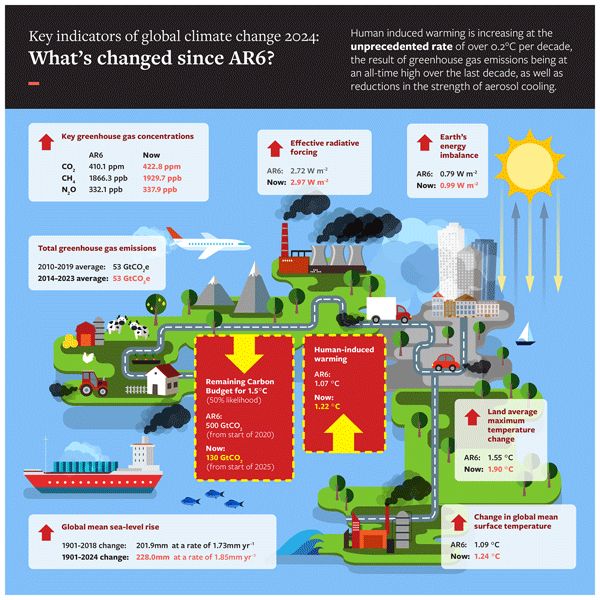
Indicators of Global Climate Change 2024: annual update of key indicators of the state of the climate system and human influence
Abstract. In a rapidly changing climate, evidence-based decision-making benefits from up-to-date and timely information. Here we compile monitoring datasets (published at https://doi.org/10.5281/zenodo.15639576; Smith et al., 2025a) to produce updated estimates for key indicators of the state of the climate system: net emissions of greenhouse gases and short-lived climate forcers, greenhouse gas concentrations, radiative forcing, the Earth's energy imbalance, surface temperature changes, warming attributed to human activities, the remaining carbon budget, and estimates of global temperature extremes. This year, we additionally include indicators for sea-level rise and land precipitation change. We follow methods as closely as possible to those used in the IPCC Sixth Assessment Report (AR6) Working Group One report. The indicators show that human activities are increasing the Earth's energy imbalance and driving faster sea-level rise compared to the AR6 assessment. For the 2015–2024 decade average, observed warming relative to 1850–1900 was 1.24 [1.11 to 1.35] °C, of which 1.22 [1.0 to 1.5] °C was human-induced. The 2024-observed best estimate of global surface temperature (1.52 °C) is well above the best estimate of human-caused warming (1.36 °C). However, the 2024 observed warming can still be regarded as a typical year, considering the human-induced warming level and the state of internal variability associated with the phase of El Niño and Atlantic variability. Human-induced warming has been increasing at a rate that is unprecedented in the instrumental record, reaching 0.27 [0.2–0.4] °C per decade over 2015–2024. This high rate of warming is caused by a combination of greenhouse gas emissions being at an all-time high of 53.6±5.2 Gt CO2e yr−1 over the last decade (2014–2023), as well as reductions in the strength of aerosol cooling. Despite this, there is evidence that the rate of increase in CO2 emissions over the last decade has slowed compared to the 2000s, and depending on societal choices, a continued series of these annual updates over the critical 2020s decade could track decreases or increases in the rate of the climatic changes presented here.
Our new paper updating key metrics in the IPCC is now out, and the news is grim:
⬆️ Human induced warming now at 1.36C
⬆️ Rate of warming now 0.27C / decade
⬆️ Sharp increase in Earth's energy imbalance
⬇️ Remaining 1.5C carbon budget only 130 GtCO2
essd.copernicus.org/...
18.06.2025 23:10 — 👍 656 🔁 485 💬 24 📌 67
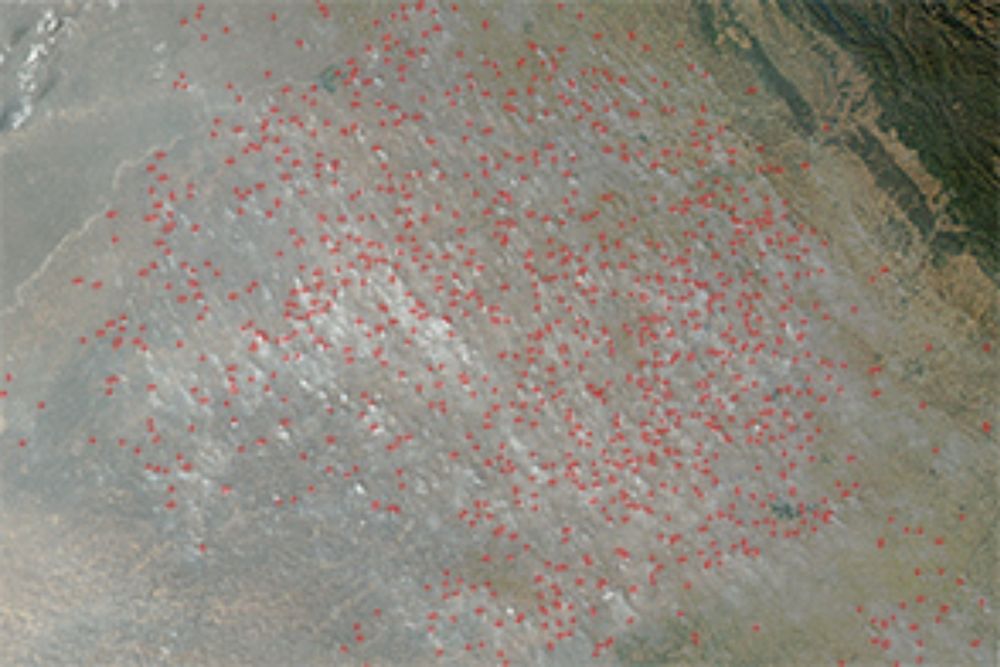
Stubble Burning in Northern India
In late-October and November, farmers in northern India burn off crop debris, a practice known as stubble burning.
Every winter, northern India grapples with a choking air crisis.
A major culprit? STUBBLE BURNING!!🌾🔥
#Agriculture #Pollution #StubbleBurning
@damonmatthews.bsky.social
earthobservatory.nasa.gov/images/84680... @damonmatthews.bsky.social
20.05.2025 19:13 — 👍 4 🔁 1 💬 1 📌 0
1/8 Ever wonder how feral dogs impact wild primates? 🐶🐒
A new study explores how the Central Himalayan Langur (Semnopithecus schistaceus) (CHL) changes its behavior when navigating a “landscape of fear” shaped by both humans and predatory dogs. Let’s make a thread. 🧵
20.05.2025 04:24 — 👍 4 🔁 1 💬 1 📌 0

The transformative potential of eDNA-based biodiversity impact assessment
Biodiversity impact assessments aim to enable market actors, regulators, and political agents to effectively steer human activities in a more sustaina…
(1/9) 🧵
The financial sector is finally waking up to the major threat of biodiversity loss. Understanding local impacts is key to making sustainable nature-positive decisions. This recent article explores how environmental DNA (eDNA) could be a game-changer.
🧬 #biodiversity
20.05.2025 03:03 — 👍 2 🔁 1 💬 1 📌 0
This was filmed at Monkey Bay, Thailand — a hotspot for tourists and crab-eating long-tailed macaques. It looks fun. But feeding wild animals might be doing more harm than good... 🧵👇 1/10
#wildlifetourism #macaques #MonkeyBay #ProvisionFeeding #animalwelfare #primateconservation
20.05.2025 01:27 — 👍 2 🔁 1 💬 1 📌 0

1/8 So I watched Wim Werner's Perfect Days and soon after started drinking Japanese canned coffee like the main character. Once the novelty wore off and my cooler head prevailed, I went down a rabbit hole of seeing whether canned was the more sustainable option for my coffee. Here's a 🧵about it ↩
19.05.2025 19:08 — 👍 3 🔁 1 💬 1 📌 0
Agriculture contributes greatly to biodiversity loss, water depletion, and GHG emissions, but to date global assessments of agricultural impacts on the environment are hindered by a lack of globally standardized spatially explicit data. Here’s how Jwaideh & Dalin (2025) tackle this challenge. 1/9
19.05.2025 15:41 — 👍 5 🔁 1 💬 1 📌 0
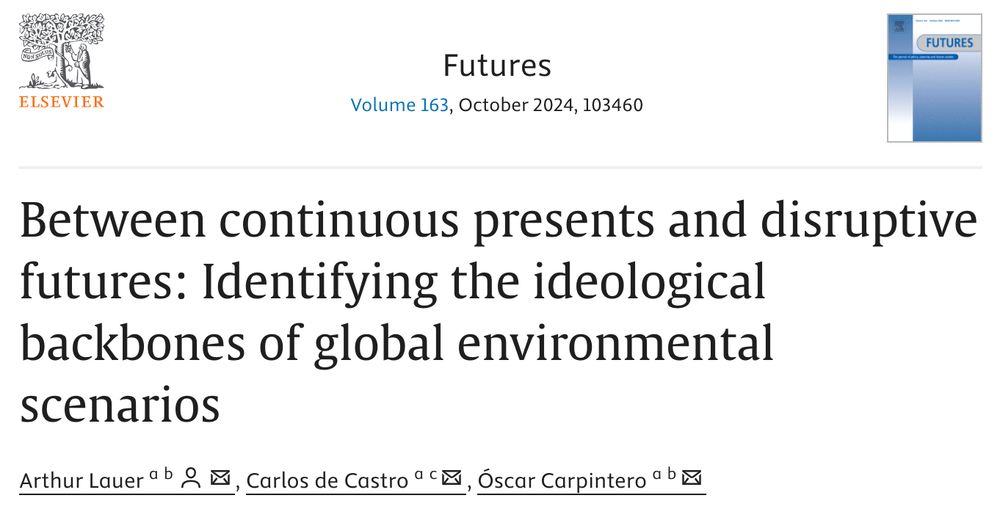
1/8 What assumptions and ideologies are represented in projected environmental futures?
In a paper published last October, a team of researchers from the University of Valladolid analyzed the ideological assumptions of 993 global environmental scenarios contained in 243 academic works.
19.05.2025 14:04 — 👍 3 🔁 1 💬 1 📌 0

What can we expect from specialty coffee in 2025?
Once defined by its passion, specialty coffee has become more pragmatic – and emerging trends push it further in this direction.
For an in-depth scope? Check out the 2022-2023 study: “The World of Coffee: 21st Century solutions for a commodity facing climate change risks” (Negre et al.) And for a smoother brew on 2025 coffee trends: perfectdailygrind.com/2025/02/what... @damonmatthews.bsky.social
18.05.2025 23:12 — 👍 1 🔁 1 💬 1 📌 0
Since COVID-19, many of us shifted how and where we work—home, cafés, hybrid setups. But what about working outdoors? A recent study found indoor work norms still dominate, yet shows outdoor work can boost focus, mood, and productivity. 🌿💻 @damonmatthews.bsky.social
17.05.2025 02:36 — 👍 2 🔁 1 💬 1 📌 0
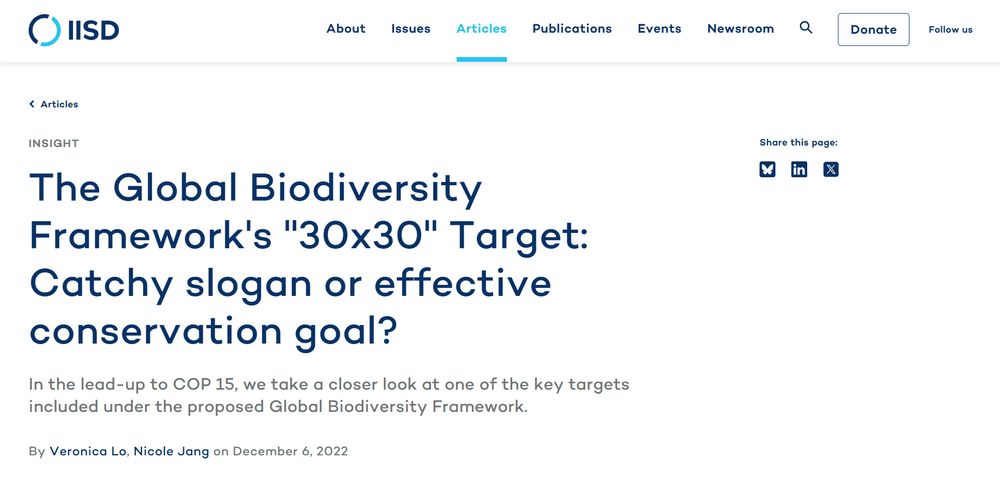
Are protected areas even useful? 🤔 Let’s deep dive into the literature and experts’ opinions on the topic
🧵 (spoiler alert: it’s complicated…)
@damonmatthews.bsky.social #protectedareas #COP15 #natureconservation
(all references in the last post) 1/10
Article link: www.iisd.org/articles/ins...
15.05.2025 19:40 — 👍 4 🔁 1 💬 1 📌 0

Exploring the past to protect the future: an analysis of conservation paleobiology in South America
Abstract Conservation paleobiology, an expanding field, employs taphonomy tools to investigate...
This is an interesting article by PhD student Anna Clara Arboitte de Assumpção from the Federal University of Rio Grande do Sul. It explores the growing field of conservation paleobiology and emphasizes the importance of this research in South America.
www.scielo.br/j/aabc/a/F4t...
15.05.2025 23:15 — 👍 3 🔁 1 💬 1 📌 0
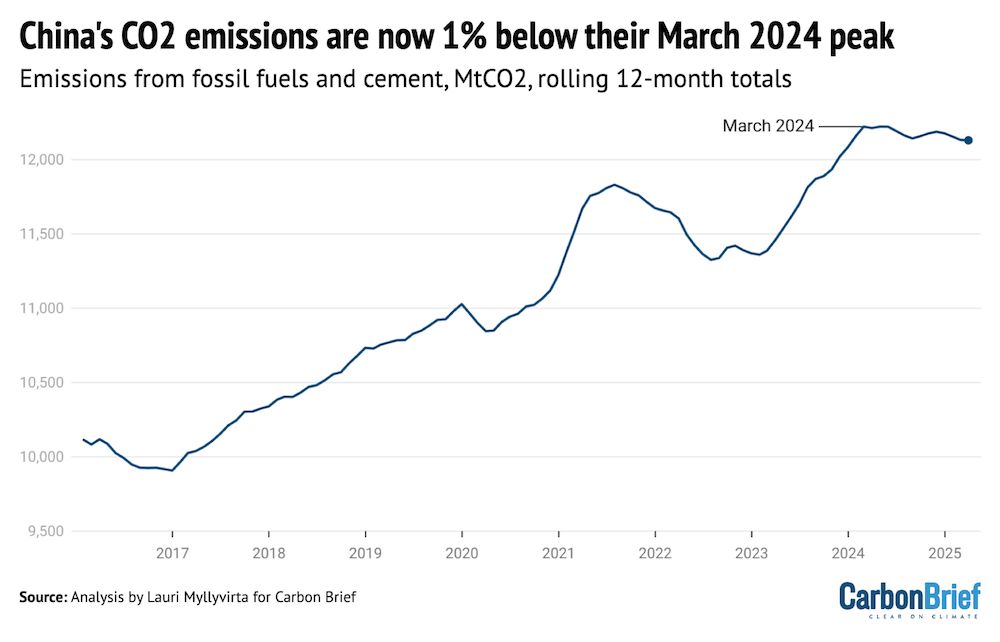
Line chart – China's CO2 emissions are now 1% below their March 2024 peak: China’s emissions from fossil fuels and cement, million tonnes of CO2, rolling 12-month totals. Source: Emissions are estimated from National Bureau of Statistics data on production of different fuels and cement, China Customs data on imports and exports and WIND Information data on changes in inventories, applying emissions factors from China’s latest national greenhouse gas emissions inventory and annual emissions factors per tonne of cement production until 2024. Sector breakdown of coal consumption is estimated using coal consumption data from WIND Information and electricity data from the National Energy Administration.
NEW – Analysis: Clean energy just put China’s CO2 emissions into reverse for first time | @laurimyllyvirta.bsky.social
Read here: buff.ly/6eAcjRU
14.05.2025 23:01 — 👍 657 🔁 244 💬 23 📌 96
There is no linearity assumption in how the warming rate is typically estimated
Also calling an entire scientific community idiotic is a rather bold statement not based on any actual evidence
02.05.2025 12:37 — 👍 0 🔁 0 💬 1 📌 0
Yes that looks about right
02.05.2025 07:17 — 👍 0 🔁 0 💬 0 📌 0
Absolutely you can! But the 5th percentile means we have a 5% chance of exceeding 2C in the next 15 years, not 90% as you led this string with.
02.05.2025 07:15 — 👍 1 🔁 0 💬 0 📌 0
My whole point was that a linear trend over only 10 years is (as you so nicely put it) linear nonsense. A linear trend through the 10 years from 2004 to 2014 gives almost no warming at all which was clearly an underestimate. Similarly the trend from 2014 to 2024 is an overestimate of the true rate
01.05.2025 20:09 — 👍 0 🔁 0 💬 2 📌 0
If you so the math on the Copernicus estimate (1.39C now and reaching 1.5C by Hune 2029), they are using 0.26C per decade
01.05.2025 20:06 — 👍 1 🔁 0 💬 0 📌 0
It’s not going to change dramatically — one additional year has limited power to shift the long-term trend
If Hansen’s estimate is just a 10-year trend drawn through the observations, I would not use this, in the same way that a 10-year trend through the hiatus period was wrong
01.05.2025 10:36 — 👍 1 🔁 0 💬 2 📌 0

Carbon majors and the scientific case for climate liability - Nature
A transparent and reproducible scientific framework is introduced to formalize how trillions in economic losses are attributable to the extreme heat caused by emissions from fossil fuel companies, whi...
Can scientists trace climate losses back to the emissions from individual fossil fuel companies?
Yes, we can.
The inimitable @ccallahan45.bsky.social and I provide an 'end-to-end' attribution framework that can be applied in many climate accountability contexts:
www.nature.com/articles/s41...
23.04.2025 15:09 — 👍 384 🔁 183 💬 12 📌 17
Climate scientist, ocean, ice, biogeochemistry, paleo, modeling 🌦️🌎🌊❄️🌡️🥼🔬💻🦖
Brooklyn Congressman. Democratic Leader.
Work hard. Stay focused. Deliver results #ForThePeople.
Oceanographer, cat enthusiast, bookworm
Researcher at UiB and BCCR, Norway / Ocean Science / Carbon Cycle / Detection and Attribution / Tipping points
Polar marine scientist. UK Science Lead in Science Coordination Office of International Thwaites Glacier Collaboration. Views are my own.
On Mastodon @PoLaRobs@fediscience.org
Physical Oceanographer, Polar Scientist, Climate Science Communicator. Working @bas.ac.uk. Views my own.
www.emmaboland.co.uk
Ocean-Science-Observing-Twinning-Sustainability CEO OceanQuest KAUST on leave from GEOMAR and Kiel University
https://www.oqfoundation.org/en/
Climate scientist & oceanographer. @royalsociety.org Professor @uniofeastanglia.bsky.social . Member @thecccuk.bsky.social #carbonbudget author.
Postdoctoral researcher at ENS Paris | Biogeochemical modeller | CDR modelling
Deputy Director, Sabin Center for Climate Change Law. Working on climate, energy, carbon removal, methane removal, and more.
Climate Scientist and marine biogeochemist at CNRS, IPSL and ENS in Paris
Physics, bubbles, oceans, hot chocolate and curiosity. Professor at UCL, writer, broadcaster. Author of Storm in a Teacup and Blue Machine https://linktr.ee/helenczerski Co-host of BBC Radio 4's Rare Earth
Researcher @SWPBerlin | Adjunct Assistant Professor @UUCopernicus | Coordinador of ESG Carbon Removal Working Group | ocean/climate governance | foresight | knowledge politics
Views my own.
Thinking about carbon removal at @CarbonPlan.org
Building progressive grassroots power and holding members of Congress accountable. Make a difference in a few clicks: https://linktr.ee/indivisibleteam
America’s Finest News Source. A @globaltetrahedron.bsky.social subsidiary.
Get the paper delivered to your door: membership.theonion.com
Researching and reporting the science and impacts of climate change 🌎
climatecentral.org
Reader and PhD student studying climate politics and governance
Montréal / Tiohtià:ke
She / her





